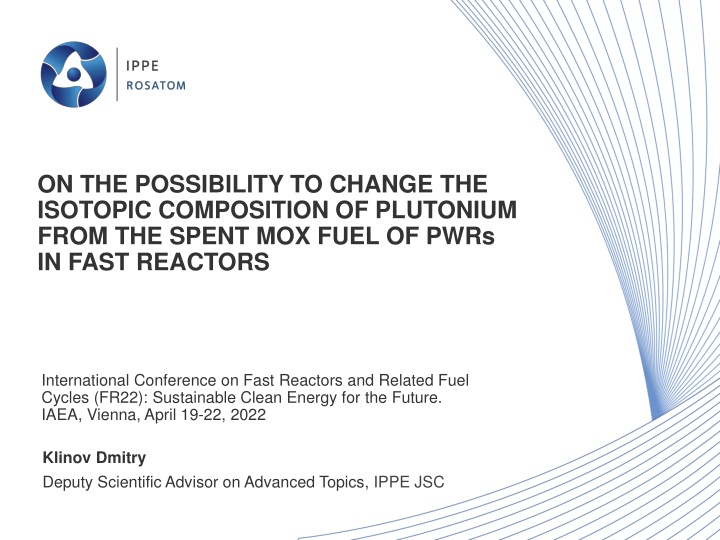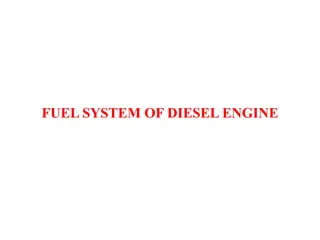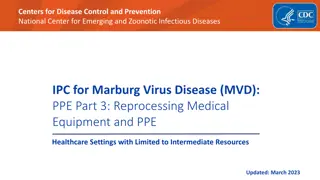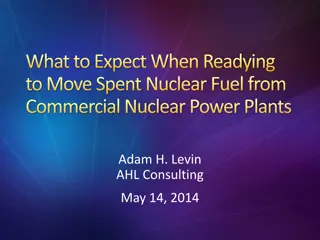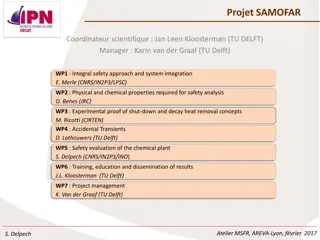Innovations in Reprocessing Spent MOX Fuel for Sustainable Nuclear Energy
Discussion at the FR22 Conference focuses on the potential for fast reactors to modify the isotopic composition of plutonium from spent MOX fuel of PWRs. By utilizing fast reactors like BN-800, countries can alter the fissile isotopes in plutonium, enabling its reuse in thermal reactors and effectively managing plutonium accumulation. Various methods and challenges in improving plutonium isotopes are examined, highlighting the need for enriched uranium in MOX fuel and the potential annual output of improved plutonium.
Uploaded on Sep 26, 2024 | 3 Views
Download Presentation

Please find below an Image/Link to download the presentation.
The content on the website is provided AS IS for your information and personal use only. It may not be sold, licensed, or shared on other websites without obtaining consent from the author.If you encounter any issues during the download, it is possible that the publisher has removed the file from their server.
You are allowed to download the files provided on this website for personal or commercial use, subject to the condition that they are used lawfully. All files are the property of their respective owners.
The content on the website is provided AS IS for your information and personal use only. It may not be sold, licensed, or shared on other websites without obtaining consent from the author.
E N D
Presentation Transcript
ON THE POSSIBILITY TO CHANGE THE ISOTOPIC COMPOSITION OF PLUTONIUM FROM THE SPENT MOX FUEL OF PWRs IN FAST REACTORS International Conference on Fast Reactors and Related Fuel Cycles (FR22): Sustainable Clean Energy for the Future. IAEA, Vienna, April 19-22, 2022 Klinov Dmitry Deputy Scientific Advisor on Advanced Topics, IPPE JSC
Introduction The world s nuclear power relies on thermal pressurized water reactors.The spent fuel from these reactors contains plutonium (up to 1% h. .). To reduce the amount of accumulated plutonium, some countries (for example, France and Japan) reuse it in the form of MOX fuel. As a result, the amount of plutonium decreases by half. However, it is impossible to further reuse plutonium extracted from MOX SNF in thermal reactors because of a high content of even isotopes. Fast reactors can change the isotopic composition of plutonium and make it suitable for reuse in thermal reactors. That will help prevent accumulation of unsuitable plutonium. At present, fast reactors are only operating in Russia (BN-600 and BN-800). That gives hope of exporting services on the improvement of the isotopic composition of plutonium from MOX SNF. 2
The mechanism for improving plutonium in fast reactors The content of fissile isotopes in Pu to be used in pressurized water reactors should be at least 61%. Improvement is due to production of Pu-239 from depleted uranium (i. . Pu breeding) and, partially, to fissioning of even Pu isotopes. Possible ways to achieve the necessary fraction of fissile isotopes: - multiple irradiation of Pu in BN-800 disadvantage : long duration of the process protracted, decreased output of improvement - use of MOX fuel based on uranium enriched to 10-15% disadvantage : costs of enriched uranium - reduction in mass fraction of plutonium in the MOX fuel in a few FAs disadvantage : low annual output of improvement - use of commercial fast reactors disadvantage : delays in the construction of such reactors. 3
Change in the isotopic composition of plutonium by its multiple recycle in BN-800 Loading, % 4.0 37.9 33.5 11.4 12.0 1.2 49.3 2.28 After After After Isotope 1 recycle, % 3.1 43.9 32.8 8.4 11.7 0.4 52.4 2.19 6 recycles, % 0.7 53.9 32.1 5.1 8.2 0.2 59.0 2.18 6 recycles + RB, % 0.7 56.7 29.4 5.0 8.0 0.2 61.7 2.18 238Pu 239Pu 240Pu 241Pu 242Pu 241Am fiss. Pu mass, t Pu mass in the radial blanket, t 0.05 2ndcolumn loaded Pu, 3rd- 5thcolumns discharged Pu. Annual output of improved Pu 250 kg/year. Disadvantage a long duration of the improvement process (~30 years). 4
Use of MOX fuel based on uranium enriched to 10-15% Enrichment of the fuel to 11-17% U-235 Composition of fresh fuel (in accordance with the enrichment zones) Low Moderate enrichment zone, % High Isotope enrichment zone, % enrichment zone, % U-238 80 77 75 U-235 11 14.5 17 PU 9 8.5 8 Composition of loaded plutonium: 4.0 / 37.9 / 33.5 / 11.4 / 12.0% ( fiss= 49.3%) Composition of plutonium after irradiation: 2.4 / 56.4 / 25.7 / 6.7 / 8.7% ( fiss= 63.0%) Annual output of improved Pu 830 kg/year. Disadvantage need for enriched uranium (to 11, 14.5, 17%)/ 5
Reduction in Pu mass fraction in a few (BN-800) core fuel assemblies 43 FAs with Pu mass fraction from MOX SNF of PWRs reduced to 10% can be placed in the core. Annual output of improved Pu is ~100 kg/year. This result is sufficient to demonstrate the potential of plutonium reuse in PWRs. France showed interest in the adjustment of Pu from MOX SNF by means of its irradiation in BN-800. An example of arranging 43 target assemblies to change Pu isotopic composition in BN-800 6
Conclusion Fast reactors with nuclear breeding (BN-800, commercial high-power fast reactors) are an effective tool to change the isotopic composition of Pu from MOX SNF of PWRs for its reuse in thermal reactors. Possible ways to change Pu isotopic composition: multiple recycle of Pu (including Pu in the radial blanket); use of partially enriched uranium; reduction in the Pu mass fraction in a few FAs. The operating BN-800 reactor can be used to demonstrate the possibility of improving representative batches of plutonium (up to 100 kg a year) and to technological processes and Pu management steps. master all the A large-scale project on Pu improvement (with Pu recycle of 1 ton per year) can be planned when a series of commercial high-power fast reactors with an increased conversion ratio are commissioned. 7
Thank you for attention Klinov Dmitry Deputy Scientific Advisor on Advanced Topics, IPPE JSC Tel.: +7 (484) 399 44 78 Mobile: +7 (910) 912 14 25 E-mail: DAKlinov@rosatom.ru www.rosatom.ru 2022
